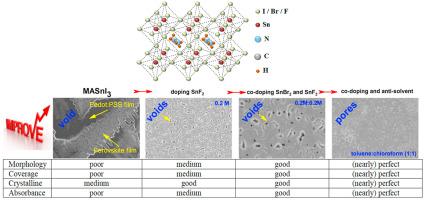当前位置:
X-MOL 学术
›
Opt. Mater.
›
论文详情
Our official English website, www.x-mol.net, welcomes your
feedback! (Note: you will need to create a separate account there.)
Optimizing quality of lead-free perovskite thin film with anti-solvent engineering and co-doping SnBr2/SnF2; its solar cell performance
Optical Materials ( IF 3.8 ) Pub Date : 2020-12-01 , DOI: 10.1016/j.optmat.2020.110524 Ali Baltakesmez , Betül Güzeldir , Yunus Alkan , Mustafa Sağlam , Mehmet Biber
Optical Materials ( IF 3.8 ) Pub Date : 2020-12-01 , DOI: 10.1016/j.optmat.2020.110524 Ali Baltakesmez , Betül Güzeldir , Yunus Alkan , Mustafa Sağlam , Mehmet Biber

|
Abstract Lead-free perovskite film is crucial for non-toxicity device applications and tin-based perovskite is one of most promising non-toxic perovskites. In this study, Br and F doping and anti-solvent washing process were investigated for suitable MASnI3 perovskite film. The structural, morphological and optical analyses showed the only Br or F doping is not enough to obtain of tin-based perovskite films having high crystallinity, surface coverage and absorbance properties. The Br and F co-doping (1 M(MAI):0.6 M(SnI2):0.2 M(SnBr2):0.2 M(SnF2)) has caused significantly decrease in morphological defects and increase crystallinity. Moreover, addition to the co-doping, void-free film morphology has been obtained by anti-solvent washing process: toluene:chloroform (1:1 vol%). Thus, oxidation of Sn2+ to Sn4+ was successfully suppressed. The optimized Sn-based perovskite film has band gap energy of 1.31 eV and atomic ratio determined to be 1.00:0.15:0.03 from the EDS and 1.00:0.16:0.07 from the XPS for I:Br:F, which indicates I-rich stoichiometric content. The solar cell application has been also performed in device structure of ITO/PEDOT:PSS (60 nm)/perovskite (272 nm)/PCBM (70 nm)/Al (100 nm). The best solar cells prepared using the co-doped perovskite films without and with anti-solvent washing process have PCE values of 2.25% with Jsc 14.9 mA/cm2, Voc 0.42 V and FF 36% and 4.45% with Jsc 17.8 mA/cm2, Voc 0.48 V and FF 52%, respectively.
中文翻译:

用反溶剂工程和共掺杂SnBr2/SnF2优化无铅钙钛矿薄膜的质量;其太阳能电池性能
摘要 无铅钙钛矿薄膜对于无毒器件应用至关重要,而锡基钙钛矿是最有前途的无毒钙钛矿之一。在这项研究中,研究了合适的 MASnI3 钙钛矿薄膜的 Br 和 F 掺杂和反溶剂洗涤过程。结构、形态和光学分析表明,仅掺杂 Br 或 F 不足以获得具有高结晶度、表面覆盖率和吸收性能的锡基钙钛矿薄膜。Br 和 F 共掺杂 (1 M(MAI):0.6 M(SnI2):0.2 M(SnBr2):0.2 M(SnF2)) 导致形态缺陷显着减少并提高结晶度。此外,除了共掺杂之外,通过反溶剂洗涤过程获得了无空隙的薄膜形态:甲苯:氯仿(1:1 vol%)。因此,成功地抑制了 Sn2+ 向 Sn4+ 的氧化。优化的 Sn 基钙钛矿薄膜的带隙能量为 1.31 eV,EDS 的原子比确定为 1.00:0.15:0.03,I:Br:F 的 XPS 确定为 1.00:0.16:0.07,这表明富含 I 的化学计量内容。太阳能电池的应用也在ITO/PEDOT:PSS (60 nm)/钙钛矿(272 nm)/PCBM (70 nm)/Al (100 nm)的器件结构中进行。使用共掺杂钙钛矿薄膜制备的最佳太阳能电池在没有和有反溶剂洗涤过程中的 PCE 值为 2.25%,Jsc 14.9 mA/cm2,Voc 0.42 V 和 FF 36% 和 4.45%,Jsc 17.8 mA/cm2, VOC 分别为 0.48 V 和 FF 52%。太阳能电池的应用也在ITO/PEDOT:PSS (60 nm)/钙钛矿(272 nm)/PCBM (70 nm)/Al (100 nm)的器件结构中进行。使用共掺杂钙钛矿薄膜制备的最佳太阳能电池在没有和有反溶剂洗涤过程中的 PCE 值为 2.25%,Jsc 14.9 mA/cm2,Voc 0.42 V 和 FF 36% 和 4.45%,Jsc 17.8 mA/cm2, VOC 分别为 0.48 V 和 FF 52%。太阳能电池的应用也在ITO/PEDOT:PSS (60 nm)/钙钛矿(272 nm)/PCBM (70 nm)/Al (100 nm)的器件结构中进行。使用共掺杂钙钛矿薄膜制备的最佳太阳能电池在没有和有反溶剂洗涤过程中的 PCE 值为 2.25%,Jsc 14.9 mA/cm2,Voc 0.42 V 和 FF 36% 和 4.45%,Jsc 17.8 mA/cm2, VOC 分别为 0.48 V 和 FF 52%。
更新日期:2020-12-01
中文翻译:

用反溶剂工程和共掺杂SnBr2/SnF2优化无铅钙钛矿薄膜的质量;其太阳能电池性能
摘要 无铅钙钛矿薄膜对于无毒器件应用至关重要,而锡基钙钛矿是最有前途的无毒钙钛矿之一。在这项研究中,研究了合适的 MASnI3 钙钛矿薄膜的 Br 和 F 掺杂和反溶剂洗涤过程。结构、形态和光学分析表明,仅掺杂 Br 或 F 不足以获得具有高结晶度、表面覆盖率和吸收性能的锡基钙钛矿薄膜。Br 和 F 共掺杂 (1 M(MAI):0.6 M(SnI2):0.2 M(SnBr2):0.2 M(SnF2)) 导致形态缺陷显着减少并提高结晶度。此外,除了共掺杂之外,通过反溶剂洗涤过程获得了无空隙的薄膜形态:甲苯:氯仿(1:1 vol%)。因此,成功地抑制了 Sn2+ 向 Sn4+ 的氧化。优化的 Sn 基钙钛矿薄膜的带隙能量为 1.31 eV,EDS 的原子比确定为 1.00:0.15:0.03,I:Br:F 的 XPS 确定为 1.00:0.16:0.07,这表明富含 I 的化学计量内容。太阳能电池的应用也在ITO/PEDOT:PSS (60 nm)/钙钛矿(272 nm)/PCBM (70 nm)/Al (100 nm)的器件结构中进行。使用共掺杂钙钛矿薄膜制备的最佳太阳能电池在没有和有反溶剂洗涤过程中的 PCE 值为 2.25%,Jsc 14.9 mA/cm2,Voc 0.42 V 和 FF 36% 和 4.45%,Jsc 17.8 mA/cm2, VOC 分别为 0.48 V 和 FF 52%。太阳能电池的应用也在ITO/PEDOT:PSS (60 nm)/钙钛矿(272 nm)/PCBM (70 nm)/Al (100 nm)的器件结构中进行。使用共掺杂钙钛矿薄膜制备的最佳太阳能电池在没有和有反溶剂洗涤过程中的 PCE 值为 2.25%,Jsc 14.9 mA/cm2,Voc 0.42 V 和 FF 36% 和 4.45%,Jsc 17.8 mA/cm2, VOC 分别为 0.48 V 和 FF 52%。太阳能电池的应用也在ITO/PEDOT:PSS (60 nm)/钙钛矿(272 nm)/PCBM (70 nm)/Al (100 nm)的器件结构中进行。使用共掺杂钙钛矿薄膜制备的最佳太阳能电池在没有和有反溶剂洗涤过程中的 PCE 值为 2.25%,Jsc 14.9 mA/cm2,Voc 0.42 V 和 FF 36% 和 4.45%,Jsc 17.8 mA/cm2, VOC 分别为 0.48 V 和 FF 52%。











































 京公网安备 11010802027423号
京公网安备 11010802027423号